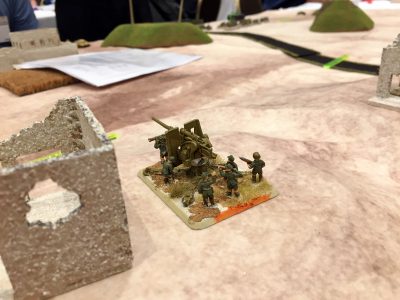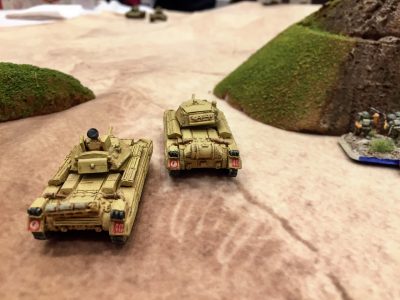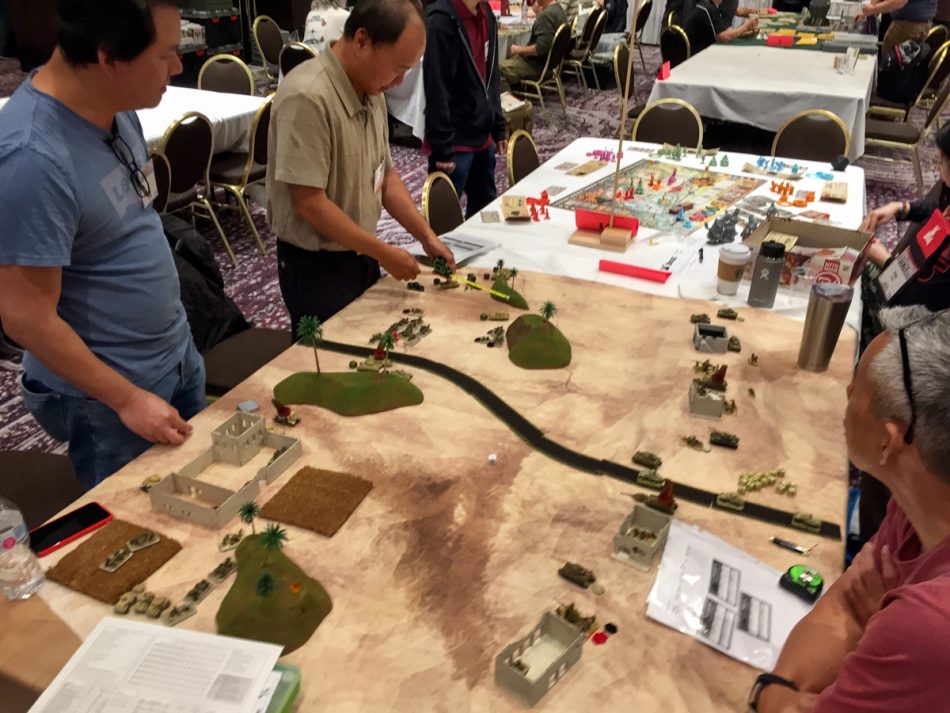BattleGroup Torch: An Intro Game
Plastic Soldier’s Company’s timing was great. I recently had the opportunity to host an intro-101 style training session at Gamex, a gaming convention in Los Angeles, California. What should show up in my mailbox a week before I had to submit event details to the convention? Battlegroup: Torch, their latest theatre book.
What follows in this piece is a combination of a look at the book itself, as well as lessons learned from applying it in a training session with players I didn’t know.
The Book
is a theatre book that details the forces available in the North African desert of WWII, centered around Operation Torch. The book covers fighting in that theatre from May ’42 to May of ’43.
In the introduction, Author Warwick Kinrade describes the book as the second half of the North Africa section. What he had hoped to make one book had quickly grown into two volumes. The first volume, , premiered in the latter half of 2017.
The Torch book includes the obvious forces of German and British, as well as American and Italian Forces that operated in that theatre. In addition, the Free French forces in the form of a March Division Battlegroup are available.
Although I was sorely tempted to make a mad rush and paint up a force of Somuas, Char Ds, and Lafflys, I decided that I didn’t have the time, nor the money to invest in new models for a one-off game right then.
Overall, I like the Battlegroup line of books, though I’d love to see their layouts updated to a more modern approach. The number one complaint I have about them is not having vehicle and guns together for known equipment, such as portee guns. I included a 2-pounder portee gun on the British side in the training game. And then I forgot to get the card out for the truck the 2-pounder was mounted on.
The forces in the training game:
The first task I tackled was setting up the force lists. Battlegroup uses a system where you need at least one platoon of infantry in every force (unless you’re playing with limited points at the squad level ).
).
Due to requirements of the convention (# of potential players), I ended up designing forces that could be broken up across three players per side. The lists ended up at 750 for the German players, and 855 for the British players. Both sides ended up with a Battle Rating of 61.
This gave both sides infantry battlegroups with a lot of armour in the backfield. I did go outside of “legal lists” to add enough “toys” (like an extra 88 gun) so that if I had to run three players per side, everyone got some fun toys.
The British ended up with Grants, Crusaders, Valentines, Humbers, and a single 2pdr Portee. Their force was mostly Regular troops. The Germans had mostly Veteran troops comprised of two 88 guns, with Pz IIIG and IV-F1s as well as some SdKfz 222 recce.
The British chit pool kept growing as they unpinned their forces.Battle Rating and Chits:
Battlegroup is a game of attrition and uses a blind Chit Draw mechanic. The chits have values of one to five, with 2s and 3s the most numerous. Certain conditions require a player to draw a chit. When the face value of all the chits drawn by a player exceeds their force’s battle rating (61 for this game) that force flees the field, and loses the game.
The Scenario:
The Torch book includes only one scenario, unlike the Tobruk book; the ridgeline assault. I modified this for the training game. I created a ridgeline with a pass along the back long edge of the German side of the table. A building overlooking the pass was an objective the German side had to hold. They began on the objective, so I didn’t have the British side draw a chit because of the objective in enemy hands.
The British were tasked with trying to drive the Germans from the ridge and capture the building overlooking the pass. Capture of the objective would force the Germans to draw a Chit.
The German side could deploy 20-inches from their edge. The British side had a 12-inch deployment zone. On the table, I used a Cigar Box battle mat, and laser-cut buildings I purchased from . The MDF buildings were easy to assemble, and I hit them with a coat of Rust-Oleum’s Stone Textured finish spray paint.
We ended up with four players: Allan and Indra took the British side, while Phil and Jason commanded the Germans. Overall, we were able to get three rounds in over four hours. The first hour included rules explanation and deployment.
The German side ended up with the first go, and rolled high for their order dice. Their coms check went through for their off-board mortars, and they managed to pin a lot of the British infantry. Their 88s and tanks used Open Fire orders and pinned a few more tank units, with one Valentine getting knocked out.
In the British turn, the order dice weren’t as nice, and the British only made a minor push toward the ridge. They tried to maximize cover, and still return fire. Not much damage was done, as several of the spot checks were missed.
British shooting knocked out a PanzerUnfortunately, the British players saw their chit draw need to unpin their units mounting quickly, and they became less aggressive. They hunkered down and tried to range in their off-board battery of 25 pounders and pin more of the German side. Unfortunately, the Dice Gods were not in their favor that day.
Finally, the game was called with the German side only needing to draw two chits, while the Brits had to keep unpinning to move.
Lessons Learned:
If I were to run this game again, I’d make the following changes:
- Give the British more deployment area, and more cover in the center of the table. They were challenged with their Regular Rating on morale checks, compared to the German’s Veteran rating. This lead to hesitant play when the order dice didn’t swing their way.
- Drop the German force another 150 points or so. Try to shift the battle rating so the German side only had about 75% of the BR of the British. Since the Brits need to be aggressive, and the Germans defensive, this would help the Brit players feel motivated to get closer faster.
- For a training game like this, I’d drop a die from the order pool. We spent a lot of time debating which unit to move or shoot. Because the order totals were in the 15 to 17 range for the Germans, this took a while and made their side bog down with a lot of shooting to resolve. Having 6 to 10 orders per side would have had the players making more choices on which units to move or shoot. This would have sped up the turn sequence, as well.
- We didn’t really get a chance to show how the flavor of the game changes as battle Chits pile up.No one was in a position of having to decide if they had the ability to draw a chit to unpin units.
 I’d definitely keep the battle rating low for the scenario, as noted above… or make some of the specials “toys” I included give a BR of zero to the total, so the players began to feel the pressure earlier.
I’d definitely keep the battle rating low for the scenario, as noted above… or make some of the specials “toys” I included give a BR of zero to the total, so the players began to feel the pressure earlier.
Overall, I’m still impressed with the play of Battlegroup. It’s designed to scale up or down in points easily and can handle a variety of model scales.
Battlegroup Torch is a good book overall, and easy to adapt to such an event. The nature of the war in the desert was adapted in the Torch and Tobruk books to allow more of a Tank on Tank game than later war Theatre books in the Battlegroup family. This helps make for a mix of many tanks, which helps draw the eye to the gaming table.
Troy is a long time gamer, and the author of the medieval fantasy series. He’s also the dude who strives to keep the typos under control on No Dice No Glory.


It would be interesting as to how their squad level game compares to Bolt Action.
The squad game for BG literally just reduces compulsory infantry to 1 squad (you can still pack a platoon if you want). That 1 squad operates the same as it would in any other size game of BG. It just means you get 1D6 orders and you can still pack a ton of tanks, armour etc.
So in BG squad size games are up to 350 points. A squad is about 30-50 points depending on forces. A platoon is anywhere from 60 points to 140 points to over 200 for a lavishly equipped veteran unit . A 3 strong platoon of medium tanks averages at about 150 points.
This is the difference between BG and BA/Chain of Command in terms of army compositions. Those other two games emphasise infantry platoons and are very restrictive in terms of support. BG is far more flexible. You can take lots of toys.
And by toys I don’t mean just tanks but armoured cars, recovery vehicles, engineering units (including bridging), ambulances, supply units etc.
Bare in mind a squad game is still like 2-3 hours of play. A platoon game (2D6 orders) is between 350 and 600-ish points (from memory) and will last several hours. The game above is a company sized game (3D6 orders).
The two games compare well, despite being different. BG is a YouGo-IGo system, while Bolt Action has the random dice draw for activation.
The comms check for the offboard arty of BG makes for an interesting dynamic. Arty in such works really well, or hardly at all.
This game might have shifted on a single die roll if we had more time to play it out.
BG is IGO-UGO but does have overwatch and reserve movement which can be activated during your opponents turn.
I ran a desert game out of Tobruk at last year’s Fall-In. About 700 points a side, but used a meeting engagement style with stuff entering the game over the first 3 turns playing down the length of the same mat you used from CBB. I put objectives near the middle to force the players to “get into it” rather than devolve the game into long distance shooting matches (which convention players will do when they are inexperienced with the game). I think it works great and allows the inexperienced players a couple of turns moving and doing some shooting.
Regarding BA vs BG – the command friction of BA is the random draw. the command friction in BG is the pinning/chit/orders dice (not everything can move each turn). It plays very well at the “1000” point BA level IMHO (roughly 400 points of BG, or platoon plus a few supports – just like BA). I ran a game at Cold Wars with 28mm Red Devils vs SS @ Arnhem.